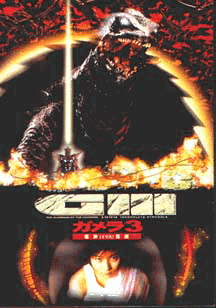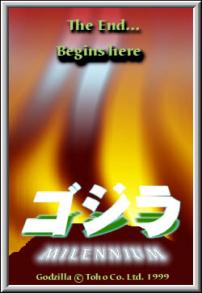|
|
|
 G
FEST -
1999
G
FEST -
1999
"The year is 1999…" Every fan of Japanese monster films recognizes those words as the beginning to "Destroy All Monsters" (1968) but while the year IS 1999, there is no man-made zoo for giant monsters on Ogasawara Island. However, for three days in July, a small section of Burbank, California was transformed into the legendary "Monster Land."
During the weekend of July 24, the Burbank Airport Hilton Hotel was the site for "G-Fest 1999," sponsored by "G-Fan Magazine." Fans of Godzilla, Gamera, Ultraman and all other Japanese "kaijuu" and "tokusatsu" films from North America and the world gathered for 3 days to watch films, buy toys and collectibles and learn more about their favorite movies. They were also able to meet the men and women who brought such giant characters to life on film, both past, present and future.
You may be surprised to know that most conventions held in America--be it Godzilla, Star Trek or Star Wars-- take place over a weekend in large hotels so that attendees and guests of the event can stay close by. Most large hotels have adequate facilities to accommodate presentations, dealer rooms and the showing of movies and videos. It is not unusual for convention attendees to be able to talk to guests of the event in the hotel bar or lobby which makes for a casual and fun atmosphere for everyone.
"G Fest 1999" took place in the "convention center" area of the hotel, which was made up a main room with several adjacent smaller rooms. When you walked into the main lobby of the building, there were many tables of dealers selling Japanese-made monster toys and collectibles. American fans of "kaijuu eiga" spend tremendous amounts of money buying the latest monster toys from Japan but find it difficult to locate such items in most cities so this was a Godzilla fan’s ultimate shopping fantasy. During the weekend at "G Fest" I spent over $200 dollars on toys. I even bought one of the small "Godzilla 2000 Millennium" figures which came with a movie ticket to see the film when it is released in December.
Throughout the entire convention, there was always something to do or see. In one room, a presentation would be given by authors and experts of "kaijuu eiga;" in the next one, videos of rare Japanese TV shows were shown. In another room, fans could participate in role-playing games; in the one next to that, incredible models of various Japanese monsters could be viewed. Finally, yet in another room, full length movies of Godzilla, Gamera and samurai films were shown. All of the rooms operated on a continuing basis so you could wander from one to the next and enjoy something different. Of course, there were special events, including a costume contest and even a live concert of music from Japanese monster films. Another nice feature was the hotel TV channel which broadcast kaijuu, sentai and tokusatsu programs all weekend long.
One of the most popular aspects of any convention is the opportunity for American fans to meet actors and directors from Japan. "G Fest" was privileged to have many such guests who seemed to be pleasantly surprised and, at times, overwhelmed by the passion and enthusiasm exhibited by American fans. The director of most of the classic Gamera films, Noriaki Yuasa, was extremely popular. As a result, fans bought many Gamera toys, videos and other collectibles for Yuasa to sign. He never hesitated to grant a fan’s request.
Shusuke Kaneko, the director of the new Gamera series, was also in attendance. Hundreds of people attended his presentation and he answered many questions and his work. Despite reports that "Gamera 3" was the last Gamera film for Kaneko, he said he would not rule out directing a fourth Gamera film, if Daiei approached him. Later, he said he would like to make "Godzilla vs Gamera" and the crowed applauded with approval.
Another popular presentation was given by the two screenwriters for the upcoming "Godzilla 2000" film, Wataru Mimura and Hiroshi Kashiwabara. American Godzilla fans are trying to find any information about the film’s story and plot, however, the two writers were very hesitant to reveal anything. Recently it was rumored on the Internet that the "UFO" that Godzilla is going to fight in the new film was not necessarily a "flying saucer" but actually a new monster. Neither Mimura or Kashiwabara could officially confirm or deny that rumor, but they did say that everything on the Internet could be considered true.
An unexpected but very welcome guest was Hisataka Kitaoka, a stunt actor who portrayed "Ultraseven" in the recent direct-to-video series, and also appeared in the last two Ultraman movies and the current TV series. He was happy to meet American fans of Ultraman, pose for photos and sign autographs for anyone who asked. Unlike most actors who desire to pursue a more serious acting path with dramatic roles, Kitaoka is intent on pursuing a career as an action star, either in Japan or the United States.
Since the release of the original of "Godzilla, King of the Monsters" in 1957, American audiences watched most Godzilla, Gamera and other Japanese productions in English. The voices that we heard were performed by various actors in New York and Hollywood who tried to respectfully interpret the Japanese actor’s performance with their own work. Two of these actors, Peter Fernandez and Corrine Orr, also came to "G-Fest" to meet fans of the films and programs they worked on. They provided some of the voices for such programs as "Speed Racer" as well as hundreds of other productions, including most of the Godzilla films and the original Ultraman series.
Another actor in attendance was Jerry Ito, who now lives in Los Angeles, but lived in Japan for 40 years. Born of Japanese and American parents, he was able to speak both languages and is most well known to monster film fans as "Clark Nelson" from the 1961 movie, "Mothra." I asked him specifically about his love scene with Kumi Mizuno in the film "Kokusai Himitsu Keisatsu: Sekai Hachigo." Despite his advanced age, he said that he "remembers that scene very, very well!"
There were other special guests at the convention: Robert Scott Field, a resident of Osaka who played the android, M-11 in 1991’s "Godzilla vs. King Ghidorah;" Steve Ryfle, author of the new book, "Japan’s Most Popular Monster;" Stuart Galbraith, author of "Monsters Are Attacking Tokyo;" Dark Horse Comics artists Bob Eggleton, dinosaur and monster author Don Glut; and "Markalite Magazine’s" Bob Johnson and August Ragone. All of them offered their expertise to convention attendees with excellent presentations.
One special team of guests were the creators and designers of "Godzilla: The Series." This series is a cartoon program currently being shown in America on The Fox Network which continues the story of the 1998 American "Godzilla" film. Keith Aiken, Tim Divar and Jay Oliva explained to the fans how the show is created and even confessed that they are always trying to incorporate characteristics of the Japanese Godzilla into the American version. Unlike the monster in the Tri-Star movie, this "anime Godzilla" has an oral heat ray which it uses to battle other monsters. The series was originally only supposed to last 13 episodes, but because it has become so popular, 40 episodes will be produced.
If all the presentations, autograph sessions and special guests were not enough, there was one last event that everyone was waiting for. Daiei Co. arranged for the U.S. premiere of "Gamera 3: Awakening of Iris" at The Egyptian Theater in Hollywood on Sunday afternoon. The long line of fans waiting to get into the theater did not go unnoticed by the local residents. Director Jon Landis ("Animal House," "Twilight Zone: The Movie") and actor Tim Russ ("Star Trek: Voyager") were curious about the film and watched it. Most American fans never have the opportunity to see a Japanese monster film in a large theater, so this was a special occasion and the theater was filled to capacity.
"Gamera 3" was spectacular. The scenes of human destruction in Shibuya as Gamera battled the Gyaos were intense and powerful. Not since the original "Godzilla" has the impact of giant monsters in a large city been portrayed so graphically. But the crowd cheered loudly over the incredible special effects which rivaled anything made in Hollywood. After the film, Kaneko answered questions about the film and seemed to have enjoyed watching the movie with an American audience.
"G-Fest 1999" was an important step to establish working relationships with Japanese companies like Toho Co. Ltd, Daiei Co. Ltd.,and Tsuburaya Productions. All three companies were generous to provide promotional materials, guests and films to "G-Fest." North America companies like ADV Films, AnimEigo Inc., Neptune Media, Simitar Video and Trendmasters also participated in the event. "G Fest" was an example of how fans can work together to enjoy their passion for Japanese monster films. Some of my favorite moments of the event were spent in the hotel bar, talking about Godzilla and Gamera with other fans until the early morning hours. I look forward to going to "G-Fest" 2000" next year and hopefully see the U.S. premiere of "Godzilla 2000 Millennium."
Photos | Interview| My Home Page